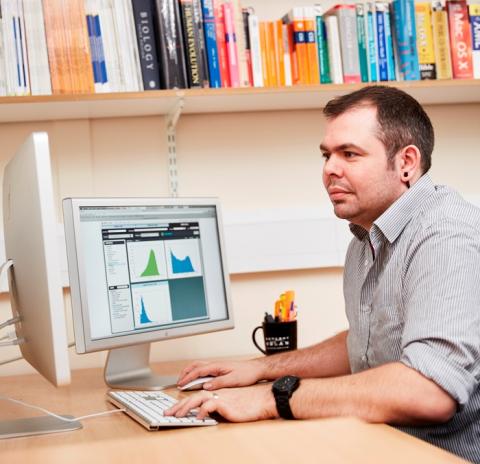James Robinson, Senior Bioinfomatics Scientist at the Anthony Nolan Research Institute, is part of the team that runs the HLA database – keeping track of the thousands of genetic variations that we come across when typing donors and patients.
Here, he tells us why that work is important and explains his latest research findings.
What are HLA genes and why are they important in transplant?
HLA stands for human leukocyte antigen, and we have five HLA genes that are key to identifying our tissue type. Our HLA genes are responsible for coding our immune system. When we’re looking for a match for a patient, HLA genes are the main thing we need to match for a successful transplant.
We inherit two copies of a gene, called alleles, one from each parent. HLA class I consists of three genes, so make up six of the alleles in a 10/10 match.
How many HLA types are there?
Most genes have very few variants, but there can be thousands of different variants for some of the HLA genes. In fact the HLA region is the most variable region of our DNA. It’s incredibly rare for genes to have such variation, and it’s a result of how our immune system evolved to withstand new infections. The more varied our immunity is, the more weapons we have against infection and diseases.
As part of our on-going work, we have developed a database that’s used for keeping track of the thousands of genetic variants that we come across when typing donors and patients. It is the main reference database for all HLA class I variants, and is used by labs and organisation from all over the world. Over the years we’ve kept adding to our database when we come across a new variant, and recently we’ve been able to estimate that there are potentially 8-9 million HLA class I alleles. This is a huge number, and it puts into perspective why it’s important to have a large, diverse pool of people on the donor register.
Will this make it harder to find a donor?
Genetic variation has always existed, but now we have a much better idea of the level of variation and the variety of tissue types in the world, and that may be the key to understanding what makes a successful match.
Not all the variants change how the immune system functions, and the majority of variants are the result of a single tiny change in the genetic code – if you compare DNA to music, the new allele is the same song with one different note. But there are clear regions of the code where we see many more variations, which suggests they have a functional role – the variations have been passed down through the generations because they give a different immune response to a particular disease.
What else will this data help with?
By categorising how many HLA variants we’ve come across, we’re helping transplant centres and donor registries understand their own data. It’s important not only to understand what the variants are but also how they arise. Understanding how new variants are formed helps to better understand unusual results, which could be a sequencing error or a new allele. We’re also ensuring that registries and transplant centres across the world are using the same language to record HLA type – registers work internationally to find donors for patients, so we all need to record data in the same way.
What’s the next step for this research?
The research has helped us to better understand the potential variation in the HLA genes and what causes it, but we have only looked at a key region in three of the six genes which are used for matching patients and donors. The next step will be to look at the other HLA genes – class II – and begin mapping those variations. This will allow us to build a more complete picture of allelic variations. We’re also looking at which variations actually have an impact on immunity, and are therefore important to match.
The existing database is very much a starting point; it includes HLA alleles from some areas of the world but not many from Africa, for example. We know that some HLA variants are only found in certain ethnicities so it’s possible that the 8-9 million variants we’ve predicted could be just the tip of the iceberg, and there are many more that appear in African populations and other ethnicities that we don’t have data for yet. We’ll keep adding to our database and our knowledge of HLA alleles, so we can better understand how the immune system works and what parts of the genetic code are important for matching.
